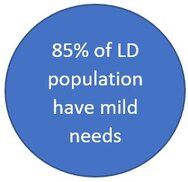What is a Learning Disability?

The NDP only assesses children for a learning disability where it is part of an assessment for Autism or ADHD. Learning disability is also known as a ‘Intellectual Disability’. Learning disability is different to a ‘specific learning difficulty’ such as dyslexia.
A learning disability (LD) affects the way a person learns new things throughout their life. It can take them longer to learn things but does not mean that they cannot learn.
A learning disability is different for everyone. No two people are the same.
A person with a learning disability might have some difficulty:
- understanding complicated information
- learning certain skills
- looking after themselves or living independently as adults
One of the most common reasons for thinking about a learning disability is if a child or young person is working significantly below the expected level in school. They may also be finding it hard to do everyday activities, such as self-care, keeping themselves safe, or coping well at school and when out and about.
It is important to remember that everyone with a learning disability is unique, there is no one type of learning disability. Each person has things that are easy for them to learn and a range of things that they find harder to learn to do. Often the person with a learning disability just needs more time to learn the things they find harder to do.
To help the person to learn and develop their independence skills sometimes we think of learning disability in terms how much support is needed – from a little to a lot.

Criteria for diagnosis
For a diagnosis of learning disability to be given there must be evidence of:
- Intellectual functioning in the extremely low range, e.g. as major difficulties with reasoning, problem solving and school learning
- Adaptive functioning difficulties (difficulties with everyday skills)
- Onset during childhood (before 18)
Last updated31 Aug 2023

